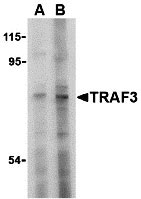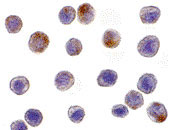TRAF3 Antibody
- 产品详情
- 实验流程
- 背景知识
Application
| WB, ICC, E |
|---|---|
| Primary Accession | Q13114 |
| Other Accession | NP_663777, 22027618 |
| Reactivity | Human, Mouse, Rat |
| Host | Rabbit |
| Clonality | Polyclonal |
| Isotype | IgG |
| Calculated MW | 64490 Da |
| Concentration (mg/ml) | 1 mg/mL |
| Conjugate | Unconjugated |
| Application Notes | TRAF3 antibody can be used for the detection of TRAF3 by Western blot at 2 - 4 µg/mL. Antibody can also be used for immunocytochemistry starting at 10 µg/mL. |
| Gene ID | 7187 |
|---|---|
| Other Names | TRAF3 Antibody: CAP1, LAP1, CAP-1, CRAF1, IIAE5, CD40bp, CAP1, TNF receptor-associated factor 3, TNF receptor-associated factor 3 |
| Target/Specificity | TRAF3; |
| Reconstitution & Storage | TRAF3 antibody can be stored at 4℃ for three months and -20℃, stable for up to one year. As with all antibodies care should be taken to avoid repeated freeze thaw cycles. Antibodies should not be exposed to prolonged high temperatures. |
| Precautions | TRAF3 Antibody is for research use only and not for use in diagnostic or therapeutic procedures. |
| Name | TRAF3 (HGNC:12033) |
|---|---|
| Function | Cytoplasmic E3 ubiquitin ligase that regulates various signaling pathways, such as the NF-kappa-B, mitogen-activated protein kinase (MAPK) and interferon regulatory factor (IRF) pathways, and thus controls a lot of biological processes in both immune and non-immune cell types (PubMed:33148796, PubMed:33608556). In TLR and RLR signaling pathways, acts as an E3 ubiquitin ligase promoting the synthesis of 'Lys-63'-linked polyubiquitin chains on several substrates such as ASC that lead to the activation of the type I interferon response or the inflammasome (PubMed:25847972, PubMed:27980081). Following the activation of certain TLRs such as TLR4, acts as a negative NF-kappa-B regulator, possibly to avoid unregulated inflammatory response, and its degradation via 'Lys-48'-linked polyubiquitination is required for MAPK activation and production of inflammatory cytokines. Alternatively, when TLR4 orchestrates bacterial expulsion, TRAF3 undergoes 'Lys-33'- linked polyubiquitination and subsequently binds to RALGDS, mobilizing the exocyst complex to rapidly expel intracellular bacteria back for clearance (PubMed:27438768). Also acts as a constitutive negative regulator of the alternative NF-kappa-B pathway, which controls B-cell survival and lymphoid organ development. Required for normal antibody isotype switching from IgM to IgG. Plays a role T-cell dependent immune responses. Down-regulates proteolytic processing of NFKB2, and thereby inhibits non-canonical activation of NF-kappa-B. Promotes ubiquitination and proteasomal degradation of MAP3K14. |
| Cellular Location | Cytoplasm. Endosome {ECO:0000250|UniProtKB:Q60803} Mitochondrion. Note=Undergoes endocytosis together with TLR4 upon LPS signaling (By similarity). Co-localized to mitochondria with TRIM35 (PubMed:32562145) {ECO:0000250|UniProtKB:Q60803, ECO:0000269|PubMed:32562145} |
For Research Use Only. Not For Use In Diagnostic Procedures.
Provided below are standard protocols that you may find useful for product applications.
BACKGROUND
TRAF3 Antibody: Tumor necrosis factor (TNF) receptor associated factors (TRAFs) are the major signal transducers for the TNF receptor superfamily and the interleukin-1 receptor/Toll-like receptor (IL-1/TLR) superfamily. TRAF3 was first identified by its interaction with CD40 and the Epstein-Barr virus transforming protein LMP1. Several TRAF3 mRNA splice variants exist and some of these can activate the transcription factor NF-κB. Besides CD40, TRAF3 also interacts with the TRFR superfamily member lymphotoxin-beta receptor (LTbetaR) in association with TRAF2 and the apoptosis inhibitors cIAP1 and Smac. It has been suggested that TRAF3 induces mitochondria-mediated apoptosis upon binding of the TNF family cytokine LIGHT by LTbetaR.
REFERENCES
Arch RH, Gedrich RW, and Thompson CB. Tumor necrosis factor receptor-associated factors (TRAFs) - a family of adaptor proteins that regulate life and death.Genes Dev. 1998; 12:2821-30.
Cheng G, Cleary AM, Ye Z, et al. Involvement of CRAF1, a relative of TRAF, in CD40 signaling. Science 1995; 267:1494-8.
Mosialos G, Birkenbach M, Yalamanchili R, et al. The Epstein-Barr virus transforming protein LMP1 engages signaling proteins for the tumor necrosis factor receptor family. Cell 1995; 80:389-99.
van Eyndhoven WG, Gamper CJ, Cho E, et al. TRAF-3 mRNA splice-deletion variants encode isoforms that induce NF0κB activation. Mol. Immunol. 1999; 36:647-58.
终于等到您。ABCEPTA(百远生物)抗体产品。
点击下方“我要评价 ”按钮提交您的反馈信息,您的反馈和评价是我们最宝贵的财富之一,
我们将在1-3个工作日内处理您的反馈信息。
如有疑问,联系:0512-88856768 tech-china@abcepta.com.























 癌症的基本特征包括细胞增殖、血管生成、迁移、凋亡逃避机制和细胞永生等。找到癌症发生过程中这些通路的关键标记物和对应的抗体用于检测至关重要。
癌症的基本特征包括细胞增殖、血管生成、迁移、凋亡逃避机制和细胞永生等。找到癌症发生过程中这些通路的关键标记物和对应的抗体用于检测至关重要。 为您推荐一个泛素化位点预测神器——泛素化分析工具,可以为您的蛋白的泛素化位点作出预测和评分。
为您推荐一个泛素化位点预测神器——泛素化分析工具,可以为您的蛋白的泛素化位点作出预测和评分。 细胞自噬受体图形绘图工具为你的蛋白的细胞受体结合位点作出预测和评分,识别结合到自噬通路中的蛋白是非常重要的,便于让我们理解自噬在正常生理、病理过程中的作用,如发育、细胞分化、神经退化性疾病、压力条件下、感染和癌症。
细胞自噬受体图形绘图工具为你的蛋白的细胞受体结合位点作出预测和评分,识别结合到自噬通路中的蛋白是非常重要的,便于让我们理解自噬在正常生理、病理过程中的作用,如发育、细胞分化、神经退化性疾病、压力条件下、感染和癌症。







